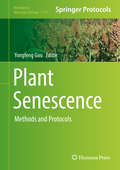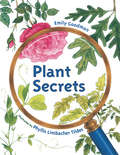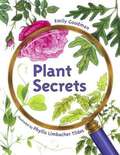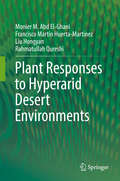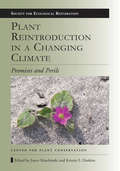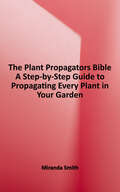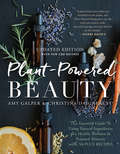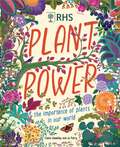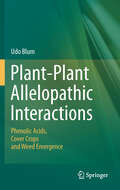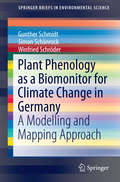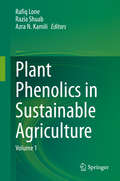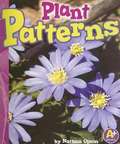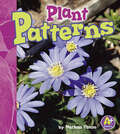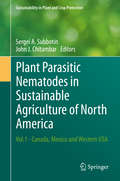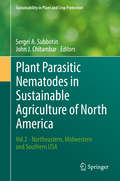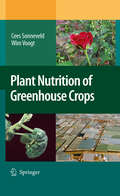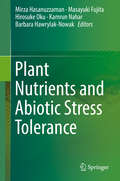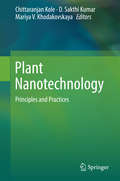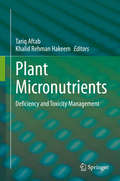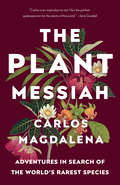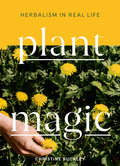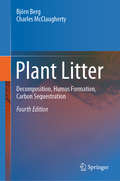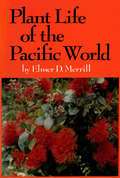- Table View
- List View
Plant Senescence
by Yongfeng GuoThis detailed volume covers a wide variety of techniques either developed specially for plant senescence studies or optimized for studying senescing plants. After an introduction to the topic, the book continues with sections on phenotypic analysis and molecular markers of plant organ senescence, hormonal control of plant senescence, stress-induced senescence, molecular and cellular processes in plant senescence, as well as systems biology approaches. Written for the highly successful Methods in Molecular Biology series format, chapters include introductions to their respective topics, lists of the necessary materials and reagents, step-by-step, readily reproducible laboratory protocols, and tips on troubleshooting and avoiding known pitfalls. Authoritative and practical, Plant Senescence: Methods and Protocols aims to provide a useful hand book of standard protocols for plant molecular biologists working on senescence.
Plant Secrets
by Emily GoodmanYoung scientists will love this nature mystery that reveals the secrets hiding in seeds, plants, flowers, and fruits throughout the life cycle of various flora. Curiosity will bloom in this introduction to botany and primary nature science. Plants come in all shapes and sizes, but they go through the same stages as they grow. Using four common plants, young readers learn about plant structure and life cycle. Simple text and colorful, detailed illustrations show the major phases of plant growth with each stage holding a &“secret&” for curious readers to guess. Back matter offers more information on each plant, as well as greater detail on each stage of growth.
Plant Secrets
by Emily Goodman Phyllis Limbacher TildesPlants come in all shapes and sizes, but they go through the same stages as they grow. Using four common plants, young readers learn about a plant's life cycles.
Plant Responses to Hyperarid Desert Environments
by Monier M. Abd El-Ghani Francisco Martín Huerta-Martínez Liu Hongyan Rahmatullah QureshiThis book provides a comprehensive discussion on plant responses in hyperarid regions of Egypt, China, Mexico, and Pakistan. It describes their location, physiographic features, accidental vegetation along two transects, endangered vegetation species, human impact, and variety of plant types (e. g. climbing, succulent, and parasitic). Studies on biotic and abiotic interactions, plant biodiversity, and soil-plant relationships are also covered. Covering a wide range of plant conditions and adaptations, this book analyzes what happens when plants must endure very high temperatures and aridity. Plants have adapted by evolving their physical structure to store and conserve water. Examples are the absence of leaves which reduces transpiration and the growth of extremely long roots, allowing them to acquire moisture at, or near the water table. Plants in hyperarid habitats have also made behavioral adaptations in order to survive by synchronizing with the seasons of greatest moisture and/or coolest temperatures. For example, desert perennials remain dormant during dry periods of the year, then spring to life when water becomes available. The book includes many color illustrations, and has extensive and up-to-date references for further reading.
Plant Reintroduction in a Changing Climate: Promises and Perils (Science Practice Ecological Restoration)
by Kristin E. Haskins Joyce MaschinskiThis volume presents a comprehensive review of reintroduction projects and practices, the circumstances of their successes or failures, lessons learned, and the potential role for reintroductions in preserving species threatened by climate change. Contributors examine current plant reintroduction practices, from selecting appropriate source material and recipient sites to assessing population demography. The findings culminate in a set of Best Reintroduction Practice Guidelines, included in an appendix to the book. These guidelines cover stages from planning and implementation to long-term monitoring, and offer not only recommended actions but also checklists of questions to consider that are applicable to projects around the world. Plant Reintroduction in a Changing Climate is a comprehensive and accessible reference for practitioners to use in planning and executing rare plant reintroductions.
The Plant Propagator's Bible: A Step-by-Step Guide to Propagating Every Plant in Your Garden
by Miranda SmithThe Plant Propagator's Bible offers all you need to know to propagate new plants from existing ones.
Plant-Powered Beauty, Updated Edition: The Essential Guide to Using Natural Ingredients for Health, Wellness, and Personal Skincare (with 50-plus Recipes)
by Amy Galper Christina DaigneaultYou know your diet should be rich in plants for optimal health. So shouldn't the products you apply to your skin, which are absorbed into your body, also be filled with plants? If you've ever looked at the back of your so-called "natural" facial moisturizer or body cream and seen a list of complicated additives you couldn't recognize or pronounce, then you know firsthand that mass-produced synthetic beauty products can be something of a mystery. With Plant-Powered Beauty: The Essential Guide to Using Natural Ingredients for Health, Wellness, and Personal Skincare (with 50-plus Recipes), harness the power of plant-based energy to maintain your natural beauty and let your skin glow like never before. Natural beauty experts Amy Galper and Christina Daigneault show readers how to deconstruct beauty labels, parse ingredients lists, make informed choices about the products they use—and, most important, better understand how their skin works. At the heart of Plant-Powered Beauty, you will find more than 50 easy-to-follow recipes to make your own plant-based skincare and beauty products, such as: • Almond Milk Facial Cleanser • Anti-aging Facial Scrub • Blemish Gel • Choc-o-Mint Lip Balm • Coconut Whip Makeup Remover • Vitamin-Rich Hair Health Serum • Quick and Fresh Cucumber-Thyme Body Scrub • Moisturizing Body Oil for Super-Dry Skin • Natural Mouthwash Plus, in this updated edition of Plant-Powered Beauty, meet the hottest wellness and beauty ingredient: cannabidiol, a very unique molecule within the Cannabis sativa plant. Research shows that CBD has a remarkable effect on the skin, including supporting tissue repair, evening skin tone, and promoting a youthful glow. New CBD recipes—for men and women!—include a salve to reduce pain, bath soak to address inflammation, facial serum for balancing, roll-on for stress relief, body butter, and more. Plant-Powered Beauty unlocks sought-after wisdom for all aspects of plant-based personal skincare and celebrates the shift in beauty trends, bringing us back to natural beauty and reconnecting us with plants and healthy choices.
Plant Power: The Importance of Plants in our World
by Claire LlewellynPlants are amazing! They are found in every part of the world, growing from tiny seeds into beautiful blooms, gigantic trees and the delicious fruit and vegetables we eat. Plants are vitally important to humans, animals and even the climate, providing food, shelter, medicines and even helping to clean our planet's air and water. This book tells you everything you need to know about plants, from how they grow, reproduce and make their own food to the variety of ways that humans and animals use plants every single day.Readers can find out about plant parts and plant life cycles, pollination, food chains, photosynthesis, seeds and plant uses, such as in food, homes, furniture, musical instruments and medicines. We find out how plants can inspire us and how we need to protect plants so they can help protect us.This book is perfect for children aged 7+.
Plant-Plant Allelopathic Interactions: Phenolic Acids, Cover Crops and Weed Emergence
by Udo BlumIn an effort to implement conservation measures farmers have used a variety of production methods, including the use of reduced or zero tillage and cover crops. One benefit of these production methods has been early season weed control. The literature suggests that a variety of mechanisms may be involved, among them the allelopathic effects of phenolic acids. This retrospective analysis addresses the following: How likely are phenolic acid concentrations and environmental conditions in wheat no-till cropping systems for the inhibition of annual broadleaf weed emergence? and Do phenolic acids have a dominant role or are they just one component of a larger promoter/modifier/inhibitor complex? The book covers allelopathic plant-plant interactions, laboratory and field experiments, and future research. It uses a journal format, provides justifications for procedures used, if-then hypotheses, and cons and pros so that readers can reach their own conclusions.
Plant Phenology as a Biomonitor for Climate Change in Germany
by Gunther Schmidt Simon Schönrock Winfried SchröderThe investigations refer to the development of plant phenology since the 1960s in Germany. Spatiotemporal trends were assessed by means of regression kriging. It could be shown that there already is a distinct shift of phenological onset towards the beginning of the year of up to two weeks. In future, a shift of up to one month was calculated till 2080. Moreover, a prolongation of the vegetation period of up to three weeks was found. The findings are relevant for the development of mitigation measures to prevent from environmental, agricultural and economic issues due to climate change.
Plant Phenolics in Sustainable Agriculture: Volume 1
by Rafiq Lone Razia Shuab Azra N. KamiliThis book presents the latest research on plant phenolics, offering readers a detailed, yet comprehensive account of their role in sustainable agriculture. It covers a diverse range of topics, including extraction processes; the role of plant phenolics in growth and development; plant physiology; post-harvesting technologies; food preservation; environmental, biotic and abiotic stress; as well as nutrition and health. Further the book provides readers with an up-to-date review of this dynamic field and sets the direction for future research. Based on the authors’ extensive experience and written in an engaging style, this highly readable book will appeal to scholars from various disciplines. Bringing together work from leading international researchers, it is also a valuable reference resource for academics, researchers, students and teachers wanting to gain insights into the role of plant phenolics in sustainable agriculture.
Plant Patterns (Finding Patterns Ser.)
by Nathan OlsonSimple text introduce different kinds of plant patterns.
Plant Parasitic Nematodes in Sustainable Agriculture of North America: Vol. 1 - Canada, Mexico And Western Usa (Sustainability In Plant And Crop Protection Ser.)
by Sergei A. Subbotin John J. ChitambarPlant-parasitic nematodes are recognized as one of the greatest threats to crop production throughout the world. Estimated annual crop losses of $8 billion in the United States and $78 billion worldwide are attributed to plant parasitic nematodes. Plant parasitic nematodes not only cause damage individually but form disease-complexes with other microorganisms thereby increasing crop loss. Nematode diseases of crops are difficult to control because of their insidious nature and lack of specific diagnostic symptoms which closely resemble those caused by other plant pathogens and abiotic diseases. Future developments of sustainable management systems for preventing major economical agricultural losses due to nematodes is focused on strategies that limit production costs, enhance crop yields, and protect the environment. This book presents a first compendium and overview for nematode problems and their management across North America. Each chapter provides essential information on the occurrence and distribution of plant parasitic nematodes, their major crop hosts, impact on crop production and sustainable management strategies for each region of the continent including, Canada, Mexico and all states of the USA. For each region, a thematic overview of changes in crop production affected by plant parasitic nematodes and their management strategies over time will provide invaluable information on the important role of plant parasitic nematodes in sustainable agriculture.
Plant Parasitic Nematodes in Sustainable Agriculture of North America: Vol. 1 - Canada, Mexico And Western Usa (Sustainability In Plant And Crop Protection Ser.)
by Sergei A. Subbotin John J. ChitambarPlant-parasitic nematodes are recognized as one of the greatest threats to crop production throughout the world. Estimated annual crop losses of $8 billion in the United States and $78 billion worldwide are attributed to plant parasitic nematodes. Plant parasitic nematodes not only cause damage individually but form disease-complexes with other microorganisms thereby increasing crop loss. Nematode diseases of crops are difficult to control because of their insidious nature and lack of specific diagnostic symptoms which closely resemble those caused by other plant pathogens and abiotic diseases. Future developments of sustainable management systems for preventing major economical agricultural losses due to nematodes is focused on strategies that limit production costs, enhance crop yields, and protect the environment. This book presents a first compendium and overview for nematode problems and their management across North America. Each chapter provides essential information on the occurrence and distribution of plant parasitic nematodes, their major crop hosts, impact on crop production and sustainable management strategies for each region of the continent including, Canada, Mexico and all states of the USA. For each region, a thematic overview of changes in crop production affected by plant parasitic nematodes and their management strategies over time will provide invaluable information on the important role of plant parasitic nematodes in sustainable agriculture.
Plant Nutrition of Greenhouse Crops
by Wim Voogt Cees SonneveldGreenhouse cultivation is noted for its high uptake of minerals, consistent climatic conditions, exclusion of natural precipitation and control of salt accumulation. Acknowledging that plant nutrition in greenhouse cultivation differs in many essentials from field production, this volume details specific information about testing methods for soils and substrates in a greenhouse environment. It does so while offering a universally applicable analysis. This is based on the composition of the soil and substrate solutions, methods for the interpretation of tissue tests, and crop responses on salinity and water supply in relation to fertilizer application. Fertilizer additions, related to analytical data of soil and substrate samples, are presented for a wide range of vegetable and ornamental crops. The subject is especially apt now as substrate growing offers excellent possibilities for the optimal use of water and nutrients, as well as the potential for sustainable production methods for greenhouse crops.
Plant Nutrients and Abiotic Stress Tolerance
by Masayuki Fujita Mirza Hasanuzzaman Hirosuke Oku Kamrun Nahar Barbara Hawrylak-NowakThis book discusses many aspects of plant-nutrient-induced abiotic stress tolerance. It consists of 22 informative chapters on the basic role of plant nutrients and the latest research advances in the field of plant nutrients in abiotic stress tolerance as well as their practical applications. Today, plant nutrients are not only considered as food for plants, but also as regulators of numerous physiological processes including stress tolerance. They also interact with a number of biological molecules and signaling cascades. Although research work and review articles on the role of plant nutrients in abiotic stress tolerance have been published in a range of journals, annual reviews and book chapters, to date there has been no comprehensive book on this topic. As such, this timely book is a valuable resource for a wide audience, including plant scientists, agronomists, soil scientists, botanists, molecular biologists and environmental scientists.
Plant Nanotechnology
by Chittaranjan Kole D. Sakthi Kumar Mariya V. KhodakovskayaThis book highlights the implications of nanotechnology in plant sciences, particularly its potential to improve food and agricultural systems, through innovative, eco-friendly approaches, and as a result to increase plant productivity. Topics include various aspects of nanomaterials: biophysical and biochemical properties; methods of treatment, detection and quantification; methods of quantifying the uptake of nanomaterials and their translocation and accumulation in plants. In addition, the effects on plant growth and development, the role of nanoparticles in changes in gene and protein expression, and delivery of genetic materials for genetic improvement are discussed. It also explores how nanotechnology can improve plant protection and plant nutrition, and addresses concerns about using nanoparticles and their compliances. This book provides a comprehensive overview of the application potential of nanoparticles in plant science and serves as a valuable resource for students, teachers, researchers and professionals working on nanotechnology.
Plant Migration: The Dynamics of Geographic Patterning in Seed Plant Species
by Jonathan D. SauerUsing cases of plant migration documented by both historical and fossil evidence, Jonathan D. Sauer provides a landmark assessment of what is presently known, and not merely assumed, about the process.
Plant Micronutrients: Deficiency and Toxicity Management
by Khalid Rehman Hakeem Tariq AftabPlants require essential nutrients (macronutrients and micronutrients) for normal functioning. Sufficiency range is the levels of nutrients necessary to meet the plant’s needs for optimal growth. This range depends on individual plant species and the particular nutrient. Nutrient levels outside of a plant’s sufficiency range cause overall crop growth and health to decline, due either to deficiency or toxicity from over-accumulation. Apart from micronutrients (B, Cl, Mn, Fe, Zn, Cu and Mo), Aluminum (Al), cerium (Ce), cobalt (Co), iodine (I), lanthanum (La), sodium (Na), selenium (Se), silicon (Si), titanium (Ti), and vanadium (V) are emerging as novel biostimulants that may enhance crop productivity and nutritional quality. These beneficial elements are not "essential" but when supplied at low dosages, they augment plant growth, development, and yield by stimulating specific molecular, biochemical, and physiological pathways in responses to challenging environments.The book is the first reference volume that approaches plant micronutrient management with the latest biotechnological and omics tools. Expertly curated chapters highlight working solutions as well as open problems and future challenges in plant micronutrient deficiency or toxicity. We believe this book will introduce readers to state-of-the-art developments and research trends in this field.
The Plant Messiah: Adventures in Search of the World's Rarest Species
by Carlos MagdalenaAn impassioned memoir of saving extraordinary plants on the brink of extinction, by a scientist who has been called a "codebreaker" (Telegraph) and "an inspiration" (Jane Goodall)Carlos Magdalena is not your average horticulturist. He's a man on a mission to save the world's most endangered plants. First captivated by the flora of his native Spain, he has travelled to the remotest parts of the globe in search of exotic species. Renowned for his pioneering work, he has committed his life to protecting plants from man-made ecological destruction and thieves hunting for wealthy collectors.In The Plant Messiah, Magdalena takes readers from the Amazon to the jungles of Mauritius to deep within the Australian Outback in search of the rare and the vulnerable. Back in the lab, we watch as he develops groundbreaking, left-field techniques for rescuing species from extinction, encouraging them to propagate and thrive once again. Along the way, he offers moving, heartfelt stories about the secrets contained within these incredible organisms. Passionate and absorbing, The Plant Messiah is a tribute to the diversity of life on our planet, and the importance of preserving it.*Featuring 16 pages of color photos*
Plant Man: The Life and Art of Makoto Azuma (Fountas & Pinnell Classroom, Guided Reading Grade 6)
by Nicole WalkerFrom Guitars to FLOWERS When a young rock musician struggled to pay his bills, he was forced to take a job doing something he never thought he'd do: work in a flower shop. But that fateful turn of events changed Makoto Azuma's life forever. His job soon evolved into a passion for transforming flowers into art. Now, his amazing and outrageous artwork never fails to surprise and delight audiences around the world. NIMAC-sourced textbook
Plant Magic: Herbalism in Real Life
by Christine BuckleyA fun, modern, and irreverent introduction to healing herbs, this field guide to feeling good includes more than 20 plant profiles.Here is an invitation to the wild world of healing plants growing right outside your door. Highlighting herbs from catnip and plantain to nettles and rosemary, this book provides the information you need to assemble an herbal arsenal for combatting any ailment—everything from brewing up a slick lube tea for sexual health to fashioning a simple summer band-aid from backyard &“weeds&” to crafting an herbal smoking blend to quiet a busy mind. This accessible guide covers questions like: What is plant medicine? What can I put in my mouth and where do I find it? Can I still go to my doctor? We&’ve got you covered.
Plant Litter: Decomposition, Humus Formation, Carbon Sequestration
by Björn Berg Charles McClaughertyThis book gives basic facts about litter decomposition studies, which are of guidance for scientists who start studies. Since the publication of the third edition, there has been quite a development not only in the field of litter decomposition but also in supporting branches of science, which are important for fruitful work on and understanding of decomposition of plant litter and sequestration of carbon. A consequence is that ‘old established truths’ are becoming outdated. New knowledge in the fields of phytochemistry and microbial ecology has given a new baseline for discussing the concepts ‘litter decomposition’ and ‘carbon sequestration’. We can also see a rich literature on litter decomposition studies using roots and wood as substrates. These have given new insights in factors that regulate the decomposition rate and as regards roots their contribution to sequestered carbon in humus. Additional facts on the role of temperature vs the litters’ chemical composition may in part change our view on effects of climate change. Further information on applications of the new analytical technique (13C-NMR) for determining organic-chemical compounds has allowed us to develop these parts. Focus is laid on needle litter of Scots pine as a model substrate as this species has been considerably more studied than other litter species. Also the boreal/northern temperate coniferous forest has in part been given this role. Still, new information may allow us to develop information about litter from further tree species.
Plant Life of the Pacific World
by Elmer D. MerrillThis Asian ecology book offers an overview of the plant life of the vast Pacific region.Among the topics covered are the tropical forest and jungles, the grasslands, the primary and secondary forest, and the plants of the seashores. <P><P>Weeds and cultivated plants are also discussed with overviews of plant distribution and notes on specific islands and island groups.Plant Life of the Pacific World will fill a great need as an important reference source not only for the ethnobotanist but for the professional botanist and the student interested in the flora of the Pacific basin. The information it contains-adequately detailed and clearly presented-should also open the eyes of both visitors and inhabitants to the natural riches of the Pacific region.
